Clive Owden goes all-out for a big hit at Horseshoe Lake and tells us about the bait he uses, how much he uses and how he decides on a spot to fish…
“HORSESHOE Lake is the perfect venue for big hit carp fishing,” said Clive Owden as we watched the water together in a swim known as the Winter Point, trying to find out where the carp were.
“There are thousands of fish in here, including several hundred over the magical 20lb mark, and they all love to eat bait. If you get it right and give them enough food in the right spot, and keep giving them food to keep them feeding in your swim, there’s no reason why you shouldn’t bag over 20 quality fish in 24 hours’ fishing. If you do this, most of the carp you land will be over 20lb.
“Twenty fish in 24 hours is actually quite a frequent catch result for the good anglers on Horseshoe, but you need to know what you’re doing to attain catches like that.
And you need to arrive prepared at the lake with the right amount of bait and the right type of tackle, because there’s no doubt about it – fishing for a big hit at Horseshoe is a bit of an art form!”
What You Need
Clive, who has fished Horseshoe for many years and is currently the venue’s head bailiff, is an exceptionally versatile angler. If he finds carp feeding off the top, he’ll catch them. He can also stalk them from the margins with PVA bags, as we saw in last month’s TC, and bait up heavily at range with spods and marker floats.
And that is precisely how he likes to go for big hits – with marker floats, spodding gear, long range tackle and as much bait as he can put in the boot of his car!
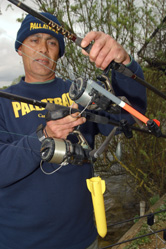 |
| 4. Marker and spod rods… Essential for ‘mass baiting’, big-hit carp fishing |
“Like I said, if you want to fish for a big hit – and this is the case anywhere in the country – you’ll need to be prepared. This sort of fishing is very demanding and very physical. You need to be committed as well as prepared if you’re to succeed doing it.
“I carry two marker float rods with me, two spod rods, at least 10kg of bait (usually more if they really start having it) and all the rest of my usual carp kit. I don’t mess around.
“Importantly, this is also a tactic that works very well if there are two of you fishing. Then you can share bait costs as well as spodding duties, and both cast to the same baited area.”
Basic Theory
So what, I asked, is the basic theory behind big hit carping? How do you go about trying to catch a large amount of fish over the course of a 24-hour (or longer) session?
“The basic theory at Horseshoe is simple,” said Clive. “You find the fish, anticipate what they will do given the conditions you have, then find a clear spot in the weed where you think the fish will be in the next 24 hours or so.
“Then you get two marker floats out, one a few yards from the other, and start spodding bait. At Horseshoe, you can begin by putting as much as 5kg of bait in the lake in one go, sometimes more if conditions are right and it looks like the fish will feed.
“This can sound quite a lot to many anglers, but you need to remember that Horseshoe carp move around in huge, hungry shoals, and when they get their heads down they can consume 5kg of bait in very little time.
“When you do start catching, the key then is to keep feeding the fish. You need to judge how much bait to keep adding to your swim. If you get it right, you can create a feeding frenzy in front of you – to such an extent that you keep the bites coming all round the clock.”
Making Clive Owden’s Spod Mix
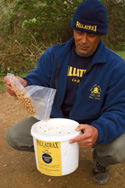 |
| Get a bucket and start by adding a couple of kilos of pellets. Clive uses two different-sized Pallatrax Coarse Pellets, which he rates. |
|
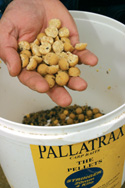 |
| Now add a few handfuls of chopped boilies. Again, Clive rates frozen Pallatrax baits, with Jungle boilies being his choice. |
|
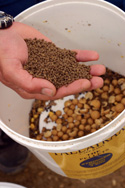 |
| A kilo or so of whole boilies are now introduced. Clive adds both 10mm and 16mm boilies at this stage, plus pellets. |
|
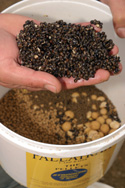 |
| Now for the hemp. Put in a few solid handfuls like this. Clive uses Dynamite’s ready-prepared hemp. |
|
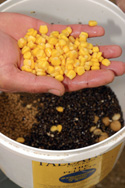 |
| A whole tin of corn goes in, too. “Corn is a great carp catcher,” says Clive. “I wouldn’t be without it.” |
|
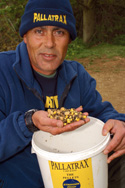 |
| The spod mix. Different baits, different sized baits – and carp love all of them. It’s a winning combination for big hit fishing! |
|
Swim Selection
Obviously, as with any type of carp fishing, swim selection is imperative if you’re to be successful. After Clive and I had watched the water for a while, he decided to set up with his good friend and well-known carp angler Ian Poole in a swim known as ‘Disabled Point’. Why there, I asked?
“There’s a strong, cool southerly wind blowing today and the forecast is for intermittent but heavy rain showers,” explained Clive.
“The fish in here love feeding in conditions like that. We’ve timed our trip just right for a feature on ‘big hit’ angling. With the experience I’ve gained over the years I’ve fished at Horseshoe, I reckon the carp will stay in an area known as The Winter Bay.
 |
| 8. This is why carp love feeding around weed… It’s full of natural food |
“The Disabled Point is perfect for those conditions. Admittedly it will be hard work fishing there, because we’ll be spodding into the strong wind, but if that’s where the fish will be later in the session, then that’s where we’ll go.”
Finding The Spot
With the swim selected, Clive and Ian got their gear out of their cars and started carrying it to the side of the lake. Bucket after bucket of Pallatrax boilies, hemp, corn, and pellets came with Clive, with Ian using Richworth kit. Clive wasn’t joking when he said you needed to come prepared. There must have been over 20kg of bait in the swim between the two anglers.
Once the gear was ready, it was a question of getting the two marker rods out, to show Clive where he was going to spod and to provide accuracy when spodding and when casting hook baits out.
“I’m not a huge fan of spodding and marker floats,” he said, “it’s too much like hard work. But there are times when it is the only method to use on well-stocked lakes like Horseshoe. You can pick up odd fish on other tactics, but if you want lots of fish, this is what you must do.”
Clive cast his marker out about 70 yards and pulled back to find gravel in among the weed. It didn’t take long. “There isn’t much weed in the Winter Bay at the moment,” he said, popping the float up about 60 yards from the bank.
“That’s not where I’d usually like to fish, but with the wind in our faces I can’t spod as accurately as I’d like any further out. Besides, the fish will come in that close anyway. The bait will pull them in!”
Ian Poole put his float out the same distance, about 15 yards to the right of Clive’s float, giving the pair quite a large target area to deposit their bait. But before the spodding began, both Clive and Ian cast in two hook baits each – even though no bait had been introduced yet.
Tying Clive’s Marker Float Rig
 |
| Thread your braided mainline through the ring of a flexi-ring swivel, then add two buffer beads and tie on the float. |
|
 |
| The two buffer beads should jam up against the float like this. This stops the float becoming stuck against the swivel. |
|
 |
| Tie a 12-inch stiff boom onto the small end of the flexi-ring swivel – and tie a 4oz lead to it. |
|
 |
| Finally, use the line clip on your reel to mark the spot you want to fish with your marker float. |
|
Spod-tastic
Attaching foam to their hook baits to aid presentation (the foam keeps the hook bait off the bottom for a few seconds after the lead has touched down, allowing the rig to settle gently on top of any silkweed that might be on the bottom of Horseshoe), both Clive and Ian cast their two rods within the area outlined by the two markers.
Why had they cast their baits in already, I wondered? Did they honestly expect to catch while spodding?
“It doesn’t happen so much now,” said Clive, “but when spodding started years ago on here you used to catch them while spodding all the time because they weren’t scared of the spods hitting the water.
“Now the fish are a bit wary of spodding. However, when you spod you can take measures to ensure you don’t spook as many carp, simply by stopping the spod 15 feet above the marked area and then feathering the line so it splashes down gently rather than with a big ‘spladoosh’!
“You’ll find that small details like this can make a big difference to the amount of fish you catch at a pressured, bait-dominated venue like Horseshoe.”
The Spod Mix
The spodding then started. What an impressive sight it was. I was so impressed!
To start with, Clive and Ian cast large Gardner Pocket Rockets filled only with water, so they landed in between the marker floats. When the spods landed in the right spots, the lines were clipped-up so every subsequent cast would land at around the same range.
Then it was time for the serious business to begin. The bait buckets were unleashed, the spods were filled and the casting began. And then carried on… And on… And on!
An hour later, both anglers stopped. To picture the scene, it was a bit like ‘duelling spods’, with Pocket Rocket and Pocket Rocket full of bait winging its way out into Horseshoe Lake. At a guess, I would say that between 5 and 8kg of bait had been introduced in that first spod session – though no carp had been caught actually during the spodding.
I was interested to see what bait Clive recommended for this type of fishing, and he was quick to say a variety of baits and bait sizes were best.
“You really want to put out baits that are of different sizes, and baits that break down in the water at different rates,” he said. “For example, if you just spodded out 5kg of hemp, the chances are the fish would become preoccupied on it to such an extent that they would ignore anything you could put on a rig.
“I like to include a number of different baits in my spod mix. Firstly I include Dynamite Hemp, which comes ready-cooked so it is hassle-free to use. Then I add two different sizes of Pallatrax Coarse Pellets, which I rate highly, along with sweetcorn and chopped Jungle boilies, also from Pallatrax.
“Finally I put in a number of whole Jungle boilies, too, in both 15mm and 10mm sizes. I really rate these boilies. Ever since I first saw them I knew that they were a quality bait – and I’ve gone on to do really well on them, landing plenty of fish over 25lb fishing over them as freebies and with them on the hook.”
How To Tape Your Mainline
 |
| Get a spool of insulating tape and cut a one-inch length from it. It needs to be insulating tape, Sellotape isn’t good enough! |
|
 |
| When your hook bait is fishing, fold the tape around your indicator. It should return to near this position each cast. |
|
 |
| Ensure the tape is stuck fast, sticky side to sticky side, and that it cannot move up and down the line. |
|
 |
| When on the line, carefully trim the tape with a sharp pair of scissors. Don’t snip the line and leave a hook bait out there! |
|
 |
| Now trim the corners to make the tape more aerodynamic. This means it passes through the rod rings easily. |
|
 |
| When you need to recast, clip your line by the tape and your rig will end up over the baited area again. |
|
Markers Wound In
When the first round of spodding had finished, the marker floats were wound in and the lads took a well-deserved break – having a cup of tea in the process.
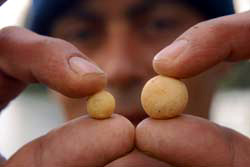 |
| These Pallatrax boilies in 10mm and 16mm are Clive’s choice. |
But before they did that, both Ian and Clive marked the mainlines on their hook bait rods so they could cast quickly and easily back to the baited area without having to resort to putting a marker float out again.
“You don’t want to be using marker floats any more then you have to,” said Clive. “They are essential for this type of fishing, but if you keep casting them out to refind the spot, you’ll end up spooking the fish away from the area – and you’ll never get a big hit.
“Instead it’s far better to clip up both your spod rods and your fishing rods, so you can spod and cast your hook baits out again and again without needing a marker float.
“However, obviously you can’t fish all the time with the reel line on your fishing rods in a clip. If you did the fish wouldn’t be able to take line on the take and you’d end up having your rod pulled into the lake.
“To get round this, I use some insulating tape on the line. I cut off a one-inch length of tape and fold it around the mono by my Mark I Fox Swinger. Then, with a pair of sharp scissors, I very carefully trim it. Then I can cast it out and it will go through the rod guides easily and won’t move up and down the mainline.
“When you need to recast the hook bait,” continued Clive, “all you do is cast out until the line reaches the tape. Then you put the line where the tape is into the clip on the reel, and cast towards the baited area. The clip stops the hook bait in exactly the right spot, bringing it down precisely over the baited area.”
First Fish!
We didn’t have long to wait for the first carp to arrive. An hour or so after the first spodding session had started, Clive’s right-hand rod was away. The result, after a manic scrap that saw the carp try to swim around the point and through Ian’s lines, was a beautiful 23lb mirror.
 |
| Ian Poole nets Clive Owden’s first fish of the session, caught over a lot of spodded bait at 60 yards out |
It looked like a big catch was on the cards. The fish had started to feed, conditions were right and, in Clive Owden and Ian Poole, two of the best carp anglers in the country were in the right place at the right time.
Or were they? In next month’s issue we’ll look at the rigs Clive uses for fishing over big beds of bait, and the hook baits he threads onto the hair. Believe me, it’s interesting stuff.
We’ll also see just how many fish Ian and Clive went on to bag. Would they get their big hit? Or would the spodding turn out to be a waste of effort? We’ll also examine when you should adopt tactics like this and when you shouldn’t. In all, it will be essential reading!
Nine Venues Where YOU Could Get A Big Hit
1. Horseshoe Lake, Lechlade – 01367 253959
2. St John’s Lake, Oxford – 07885 327708
3. Drayton Reservoir, Northants – 07889 532563
4. Orchid Lake, Oxford – 01865 341810
5. Chilham Mill, Kent – 01227 730668
6. Hardwick Lake, Oxford – 07885 327708
7. Catch 22, Norfolk – 01603 872948
8. Broadlands, Hampshire – 02380 869881
9. Bluebell Lake, Northants – 01832 226042
Total Carp


























